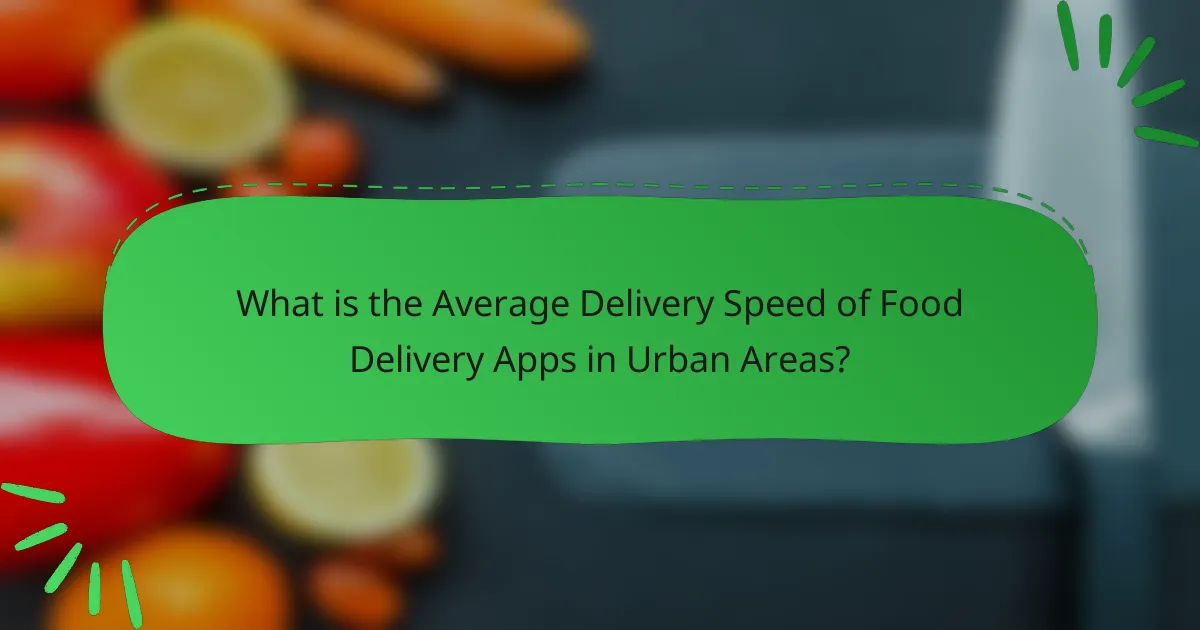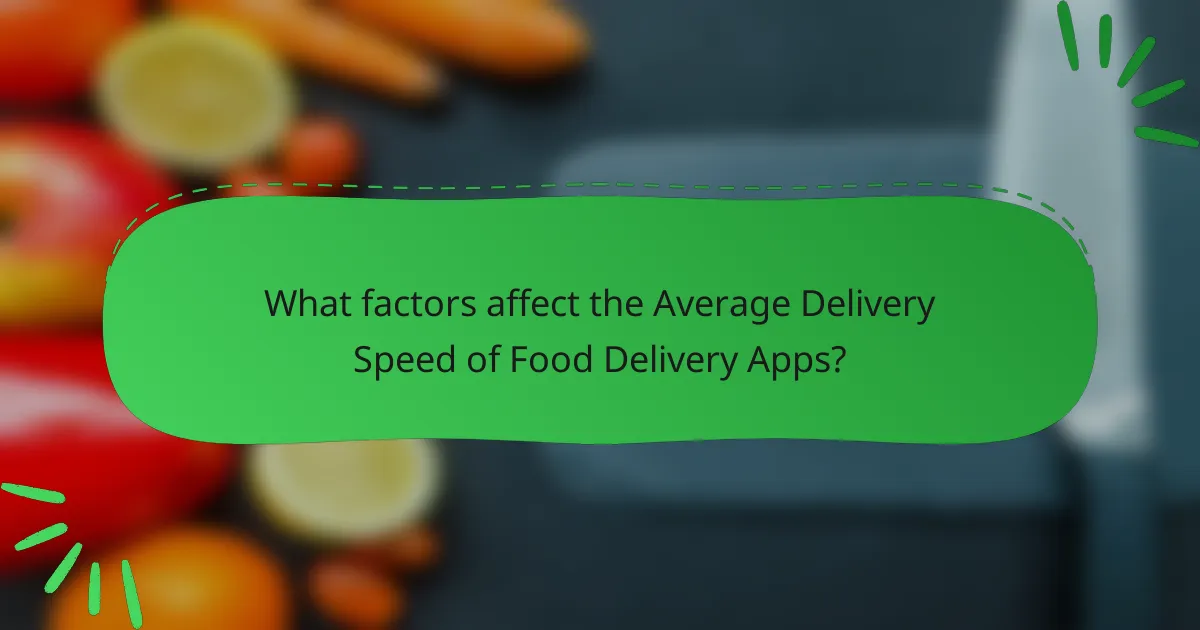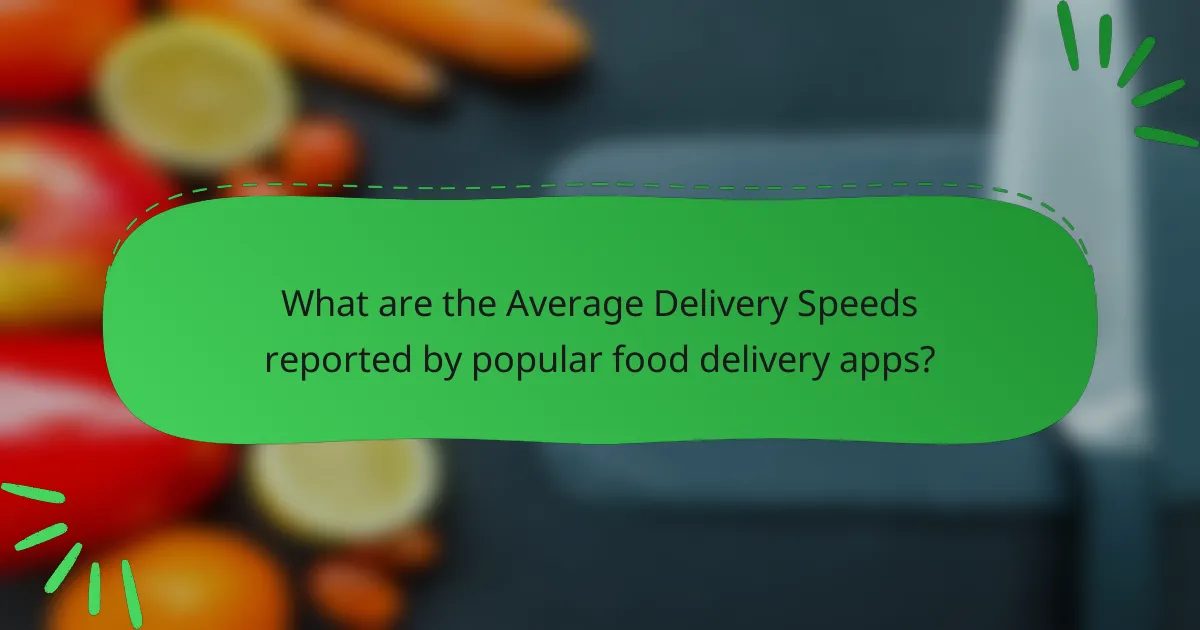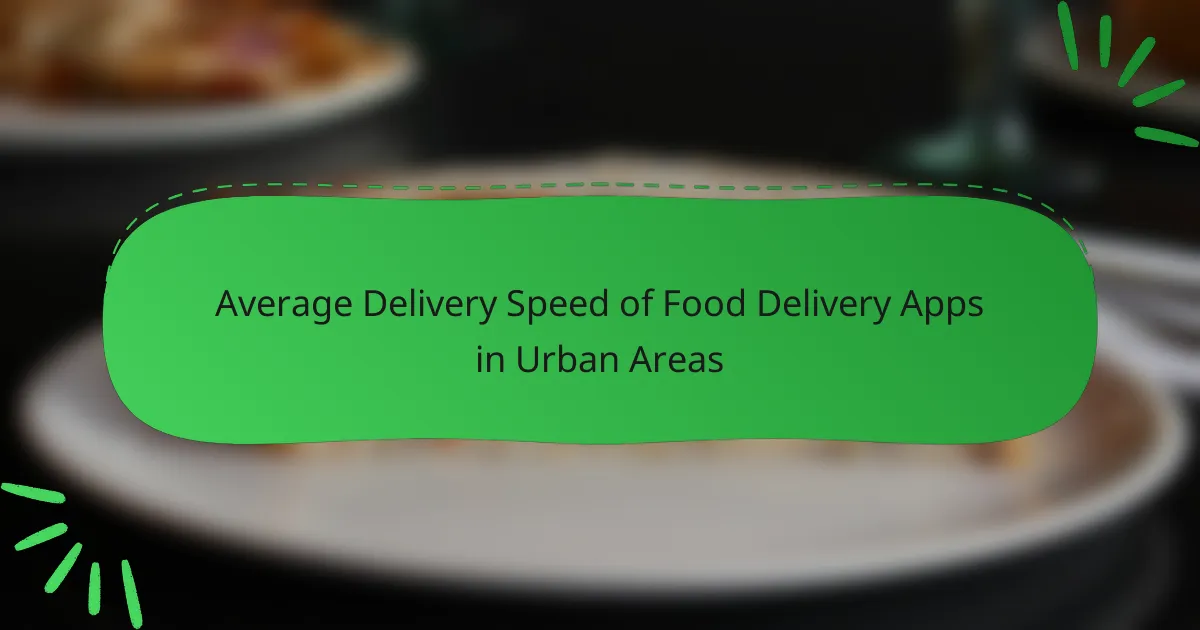The article examines the average delivery speed of food delivery apps in urban areas, which typically ranges from 30 to 45 minutes. Key factors influencing delivery times include distance from the restaurant, traffic conditions, and peak demand during meal times. Research indicates that 60% of consumers expect their food to arrive within 30 minutes, highlighting the importance of efficiency in delivery logistics. Additionally, the performance of delivery personnel and the optimization of routes can significantly impact delivery speed, with studies suggesting that route optimization can reduce delivery times by up to 20%. Popular apps like DoorDash, Uber Eats, and Grubhub report varying average delivery speeds, reflecting the complexities of urban food delivery dynamics.

What is the Average Delivery Speed of Food Delivery Apps in Urban Areas?
The average delivery speed of food delivery apps in urban areas is approximately 30 to 45 minutes. This timeframe can vary based on factors such as traffic, distance, and order volume. Research indicates that urban areas experience higher demand, which can affect delivery times. A study by Statista shows that 60% of consumers expect their food to arrive within 30 minutes. Additionally, peak hours may lead to longer wait times. Overall, urban delivery speeds are designed to be efficient, balancing customer satisfaction and operational logistics.
How is delivery speed measured in food delivery apps?
Delivery speed in food delivery apps is measured by the time taken from order placement to delivery completion. This includes various phases such as order preparation time and transit time. Order preparation time is the duration needed for restaurants to prepare the food. Transit time accounts for the duration taken by delivery personnel to reach the customer’s location.
Apps often provide estimated delivery times based on historical data and real-time traffic conditions. They may also track the delivery in real-time, allowing customers to see updates. Data analytics plays a crucial role in improving accuracy. By analyzing past delivery times, apps can refine their estimates for future orders.
What metrics are commonly used to assess delivery speed?
Common metrics used to assess delivery speed include average delivery time, on-time delivery rate, and delivery time variance. Average delivery time measures the mean duration from order placement to delivery completion. On-time delivery rate indicates the percentage of orders delivered within the promised timeframe. Delivery time variance reflects the consistency of delivery times across multiple orders. These metrics help businesses evaluate efficiency and customer satisfaction. Studies show that reducing average delivery time can significantly enhance customer loyalty.
How do different apps report their delivery speeds?
Different apps report their delivery speeds using various metrics. These metrics often include estimated delivery time and real-time tracking updates. Apps may show average delivery speeds based on historical data. Some provide a countdown timer during the delivery process. Others may allow users to rate delivery speed after completion. Companies like Uber Eats and DoorDash often display average delivery times for specific areas. Research indicates that transparency in delivery speed enhances customer satisfaction. According to a study by the Journal of Business Research, timely updates significantly improve user experience.
Why is delivery speed important for food delivery apps?
Delivery speed is crucial for food delivery apps because it directly impacts customer satisfaction. Fast delivery enhances the overall user experience and encourages repeat business. According to a study by Statista, 70% of consumers expect food to arrive within 30 minutes of placing an order. Delays can lead to negative reviews and loss of customers. Additionally, quicker delivery times can increase the number of orders a restaurant can fulfill in a given period. This efficiency benefits both the app and the restaurant partners. In competitive urban markets, speed can differentiate one app from another. Thus, maintaining high delivery speeds is essential for success in the food delivery industry.
What impact does delivery speed have on customer satisfaction?
Delivery speed significantly impacts customer satisfaction. Faster delivery times lead to higher satisfaction levels among customers. Research indicates that 88% of consumers are less likely to order again if their food arrives late. Customers value timely service, especially in food delivery, where freshness is critical. A study by Deloitte found that delivery speed is a primary factor in customer loyalty for food delivery apps. Enhanced delivery speed can also improve a brand’s reputation and customer retention. In urban areas, where competition is high, quick delivery can differentiate a service from its competitors.
How does delivery speed influence repeat business for food delivery apps?
Delivery speed significantly influences repeat business for food delivery apps. Faster delivery times lead to higher customer satisfaction. Satisfied customers are more likely to order again. Research shows that 60% of users prefer apps with quicker delivery options. Additionally, a study by QSR Magazine found that 70% of customers are likely to reorder from an app that delivers within 30 minutes. Delays can result in negative experiences, reducing the likelihood of repeat orders. Therefore, optimizing delivery speed is crucial for retaining customers in the competitive food delivery market.

What factors affect the Average Delivery Speed of Food Delivery Apps?
The average delivery speed of food delivery apps is affected by several key factors. These factors include distance from the restaurant to the customer, traffic conditions, and the time of day. Longer distances typically result in slower delivery speeds due to increased travel time. Traffic congestion can significantly hinder the speed of delivery, especially during peak hours. The time of day also plays a role, as demand surges during meal times can lead to delays. Additionally, the efficiency of the delivery personnel and the app’s route optimization algorithms can influence delivery speed. Studies have shown that optimizing delivery routes can reduce average delivery times by up to 20%.
How do urban environments impact delivery speed?
Urban environments significantly impact delivery speed. High population density leads to increased traffic congestion. This congestion slows down delivery vehicles, resulting in longer wait times. Urban infrastructure, such as narrow streets or one-way systems, can further hinder access. Additionally, the presence of pedestrians and cyclists adds complexity to navigation. Studies indicate that delivery times can increase by 30% in congested urban areas compared to suburban locations. Moreover, varying weather conditions in cities can also cause delays. Overall, urban environments present unique challenges that directly affect the efficiency of food delivery services.
What role does traffic congestion play in delivery time?
Traffic congestion significantly increases delivery time. It creates delays in transit for delivery vehicles. As vehicles navigate through congested areas, they travel slower. This slowdown leads to longer routes and increased wait times. Studies show that traffic congestion can add 20-30 minutes to delivery times in urban settings. For instance, a report by INRIX indicates that U.S. drivers lose an average of 97 hours annually due to congestion. Consequently, food delivery apps often struggle to meet estimated delivery windows. This affects customer satisfaction and operational efficiency.
How do urban density and layout influence delivery routes?
Urban density and layout significantly influence delivery routes by affecting travel time and accessibility. Higher urban density often leads to congested streets, which can slow down delivery vehicles. Narrow streets and limited parking options complicate the ability to make timely deliveries.
Conversely, a well-planned urban layout with designated delivery zones can enhance efficiency. Research indicates that urban areas with mixed land use reduce the distance between delivery points. This proximity allows for quicker deliveries and shorter routes.
Additionally, the presence of one-way streets can create detours, impacting overall delivery speed. A study by the Transportation Research Board highlights that urban design directly correlates with delivery efficiency metrics. Thus, urban density and layout play crucial roles in shaping effective delivery routes.
What operational aspects can affect delivery speed?
Operational aspects that can affect delivery speed include route optimization, order volume, and driver availability. Route optimization ensures drivers take the fastest paths to reach customers. High order volume can lead to delays as drivers juggle multiple deliveries. Driver availability impacts how quickly orders can be picked up and delivered. Traffic conditions also play a crucial role in delivery speed, as congestion can slow down drivers. Additionally, the efficiency of the restaurant’s preparation time affects how quickly orders are ready for pickup. Finally, the effectiveness of communication between the app, drivers, and customers can influence overall delivery efficiency.
How does the size of a delivery fleet impact delivery efficiency?
The size of a delivery fleet directly impacts delivery efficiency. A larger fleet can reduce delivery times by increasing the number of available drivers. This allows for more orders to be fulfilled simultaneously. In contrast, a smaller fleet may lead to longer wait times for customers. Research shows that companies with larger fleets can achieve delivery speeds up to 20% faster. This is due to better coverage of urban areas and reduced distances between drivers and customers. Additionally, larger fleets can adapt more easily to demand fluctuations. This flexibility ensures that deliveries are made promptly, enhancing customer satisfaction.
What technology improvements can enhance delivery speed?
Automation in logistics can significantly enhance delivery speed. Technologies such as AI and machine learning optimize route planning. These systems analyze traffic patterns and predict delays. Real-time tracking improves communication between drivers and customers. Drones and autonomous vehicles are emerging solutions for faster deliveries. According to a 2021 study by McKinsey, automation can reduce delivery times by up to 30%. Integrating smart warehousing systems also accelerates order processing. Efficient inventory management ensures quicker access to products. Overall, these technological advancements streamline operations and enhance delivery efficiency.

What are the Average Delivery Speeds reported by popular food delivery apps?
The average delivery speeds reported by popular food delivery apps vary. Typically, these speeds range from 30 to 45 minutes. For instance, DoorDash averages around 35 minutes per delivery. Uber Eats reports an average speed of about 30 to 40 minutes. Grubhub often falls within a similar range, averaging approximately 40 minutes. These times can fluctuate based on factors like location and time of day. Data from customer surveys and app performance reports support these averages.
How do different apps compare in terms of average delivery speed?
Different food delivery apps exhibit varying average delivery speeds. For instance, Uber Eats averages around 30 minutes per delivery. DoorDash typically delivers in about 35 minutes. Grubhub’s average delivery time is approximately 40 minutes. Postmates, on the other hand, can take around 45 minutes. These times can fluctuate based on factors such as location, order volume, and time of day. A study by Statista in 2021 confirmed these averages across major urban areas.
What are the average delivery times for leading food delivery apps?
The average delivery times for leading food delivery apps typically range from 30 to 60 minutes. Apps like Uber Eats and DoorDash often deliver within 30 to 40 minutes in urban areas. Grubhub tends to average around 40 to 50 minutes for delivery. Postmates may take slightly longer, averaging 45 to 60 minutes. These times can vary based on factors such as distance, restaurant preparation time, and traffic conditions. Research indicates that urban settings generally experience faster delivery times due to proximity to restaurants.
How do peak hours affect average delivery speeds across different apps?
Peak hours significantly reduce average delivery speeds across different food delivery apps. During peak hours, demand increases, leading to higher order volumes. This congestion causes delays in food preparation and delivery logistics. For instance, a study by the University of California found that delivery times can increase by up to 30% during dinner rush hours. Traffic congestion further exacerbates these delays. Additionally, limited availability of delivery personnel during peak times contributes to slower service. Apps may also experience technical issues under heavy load, impacting speed. Overall, peak hours create a compounded effect on delivery efficiency across various platforms.
What trends are emerging in food delivery speed in urban areas?
Emerging trends in food delivery speed in urban areas include increased use of technology and optimized logistics. Many food delivery apps are leveraging artificial intelligence to predict delivery times more accurately. This technology can analyze traffic patterns and weather conditions in real-time. Additionally, the rise of dark kitchens is contributing to faster delivery speeds. These kitchens are strategically located to minimize delivery distances. Research indicates that average delivery times have decreased by 20% in major cities over the past year. Delivery companies are also utilizing bicycles and scooters for quicker transport in congested areas. These trends reflect a growing demand for speed and efficiency among urban consumers.
How is technology shaping the future of delivery speeds?
Technology is significantly enhancing delivery speeds through innovations such as automation, real-time tracking, and advanced logistics. Automation in warehouses and delivery processes reduces handling time. Drones and autonomous vehicles are being tested for faster delivery routes. Real-time tracking allows customers to monitor their orders, improving efficiency. Advanced algorithms optimize delivery routes, minimizing delays. According to a study by McKinsey, companies using AI in logistics can reduce delivery times by up to 30%. These technological advancements are shaping a future where faster and more efficient delivery becomes the norm.
What are the anticipated changes in consumer expectations regarding delivery speed?
Consumers are expected to demand faster delivery speeds in the coming years. This shift is driven by the increasing reliance on technology and convenience. Studies show that 88% of consumers prioritize delivery speed when choosing food delivery services. Additionally, the rise of same-day and even one-hour delivery options has set a new standard. As competition intensifies among food delivery apps, companies will need to adapt to these heightened expectations. Research indicates that consumers are willing to pay more for faster service. Therefore, the trend suggests a significant increase in the demand for rapid delivery solutions.
What tips can consumers use to optimize their food delivery experience?
To optimize their food delivery experience, consumers should choose peak delivery times wisely. Ordering during off-peak hours often leads to faster service. Consumers should also provide clear delivery instructions. Specific directions can help drivers locate their destination quickly. Additionally, selecting restaurants with high ratings can improve food quality and delivery speed. Research shows that well-rated establishments tend to have more efficient operations. Tracking the delivery in real-time allows consumers to stay updated. This feature can help manage expectations regarding arrival times. Finally, maintaining communication with the delivery driver can resolve issues promptly. Clear communication enhances the overall delivery experience.
How can consumers choose the best time for quicker delivery?
Consumers can choose the best time for quicker delivery by analyzing peak and off-peak hours. Delivery apps often experience delays during busy meal times, such as lunch and dinner. Ordering during off-peak hours can significantly reduce wait times. Research shows that delivery speeds can improve by up to 30% during these quieter periods. Additionally, consumers should check the app for estimated delivery times before placing an order. Some apps provide real-time updates on delivery status, helping consumers make informed decisions. By planning orders around these insights, consumers can enhance their delivery experience.
What should consumers consider when selecting a food delivery app for speed?
Consumers should consider the estimated delivery time provided by the app. This time often reflects the average speed based on historical data. They should also check real-time tracking features. These features can give updates on the delivery status. Additionally, consumers should look at user reviews. Reviews can provide insights into the reliability of delivery speed. Another factor is the restaurant’s distance from the consumer. Closer restaurants typically lead to faster delivery. Lastly, the time of day can affect speed. Peak hours may result in longer wait times.
The main entity of this article is the average delivery speed of food delivery apps in urban areas. The article provides an overview of the typical delivery times, which range from 30 to 45 minutes, and examines the factors influencing these speeds, such as traffic conditions, distance, and order volume. It discusses how delivery speed is measured, common metrics used to assess it, and the impact of urban environments on efficiency. Additionally, the article highlights the importance of delivery speed for customer satisfaction and repeat business, as well as emerging trends and technology shaping the future of food delivery services.
